Don J. Easterbrook, Dept. of Geology, Western Washington University, Bellingham, WA
The recent Portland State University study of glaciers on Mt. Adams by is a good example of bad science, i.e., how a dogmatic bias and selectively leaving out contrary factual data can lead to bad conclusions. As an exercise in critical thinking, I used to have my graduate students take a paper like this apart, piece by piece, to show any scientific errors. Here is an analysis of bad assumptions and errors in the Mt. Adams study.
First, what are the basic contentions in this study?
1. Washington’s gradually warming temperatures have caused Mount Adams to shrink by nearly half since 1904.
2. The Mt. Adams glaciers are receding faster than those of nearby sister volcanoes.
3. The glacier recession is another sign of gradually warming temperatures.
4. The study lends urgency to an earlier federal report that shows the water content of Cascade Mountain snowpacks could dwindle by as much as 50 percent by the 2070s.
Let’s take a careful look at each of these. Have the Mt. Adams glaciers indeed shrunk by nearly half since 1904? How do we prove such a statement? The best way is to have photographic evidence of where the glacier termini were in 1904 and where they are now. For the moment, let’s assume they have shrunk significantly since 1904. But the rest of the conclusion (gradually warming temperatures have caused them to shrink) isn’t a logical consequence of smaller glaciers. Two important aspects of this question are (1) has the climate gradually warmed over the past 100 years and (2) what were the glaciers doing before 1904?
The answer to the question, has the climate gradually warmed over the past 100 years, is no, the climate has not gradually warmed - it has oscillated back and forth between warm and cool periods four times during the past century (Figure 1), and the glaciers have fluctuated back and forth with the climate changes. The inference that the Mt. Adams glaciers began to retreat near the turn of the past century and have gradually shrunk because of gradual warming due to increased CO2 is false.
>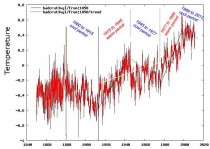
Figure 1. The climate during the past century has fluctuated through two periods of global warming and two periods of global cooling. Each time the climate cooled, the glaciers advanced; each time the climate warmed, they retreated.
The answer to the question, what were the glaciers doing immediately prior to 1904 is that they were strongly advancing during the 1880 to 1915 cool period, and many reached terminal positions close to their maximum extent during the Little Ice Age (1300 AD to this century) (Figure 2). Most of the subsequent retreat of the glaciers occurred during the following warm period from 1915 to 1945, well before CO2 began to rise sharply after 1945.
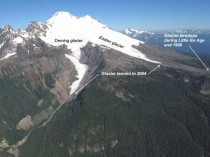
Figure 2. Position of glacier termini of the Easton and Deming glaciers on Mt. Baker (another Cascade volcano similar to Mt. Adams). The glacier termini in 1906 were close to their maximum Little Ice Age extent because of 30 years of strong climatic cooling from 1880 to about 1915. The recent glacier termini are at their minimum extent because of the preceding 20 years (1978 to 1998) of climatic warming.
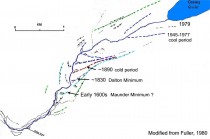
Figure 3. Successive positions of the terminus of the Deming glacier on Mt. Baker from the Little Ice Age to 1979. Each of these terminal positions corresponds to strong readvances of ice during periods of climatic cooling, separated by periods of glacial recession. The climate has been generally warming for 500 years coming out of the Little Ice Age, well before atmospheric CO2 began to rise after 1945, and has been characterized by alternating periods of warming and cooling to the present, not gradually warming because of increased CO2. The glaciers on Mt. Rainier and Mt. Adams show similar fluctuations.
Let’s look at the second contention--Mt. Adams glaciers are receding faster than those of nearby sister volcanoes. The advance and retreat of glaciers on two of those sister volcanoes, Mt. Baker and Mt. Rainier, has been well documented (Figure 4) (see references in Easterbrook 2011 and 2010).
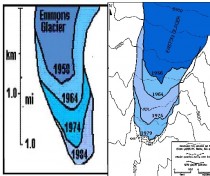
Figure 4a. Advance of more than 1 km of the Emmons glacier terminus on Mt. Rainer from 1958 to 1984. Figure 4b. Advance of the Easton glacier from 1956 to 1979
Glaciers on Mt. Rainier and Mt. Baker advanced strongly during the 1880 to 1915 cool period, retreated strongly during the 1915 to 1945 warm period, advanced again during the 1945 to 1977 cool period, and retreated during the 1978 to 1998 warm period. The contention that Mt. Adams glaciers are retreating faster than those on nearby volcanoes and that they have been retreating gradually since 1904 is false. Glaciers on Mt. Adams have not been gradually retreating and are ‘not retreating faster than the others’--all of these volcanoes have fluctuated strongly back and forth during each period of warming and cooling.
The third contention of the study, that glacier recession is another sign of gradually warming temperatures is only partially true. Although climatic warming does indeed cause glacier recession, the inference that gradual warming has caused gradual glacier retreat since 1904 is not true. The glaciers have clearly been periodically advancing as well as retreating.
The forth contention of the study, that the study lends urgency to an earlier federal report that shows the water content of Cascade Mountain snowpacks could dwindle by as much as 50 percent by the 2070s is totally unfounded. It assumes (1) that gradual climatic warming dating back to 1904 will continue at a constant rate until 2070, (2) that the supposed warming is continuous, (3) that the climate will continue to warm, and (4) that it is caused by increasing atmospheric CO2. The first assumption of gradual warming since 1904 has been shown above to be incorrect-there have been warming and cooling periods that have caused glaciers not only to retreat, but also to advance during this time. The assumption that the climate is presently warming is also not true--in fact, the climate has been cooling slightly since 2000, not warming, so projecting continuous gradual warming into the future is not warranted.
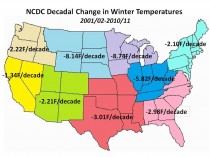
Figure 5. Winter temperatures in the US over the past decade. Note that temperatures in the Pacific NW have cooled at a rate of 2.22F per decade, not warmed.
The assumption that CO2 is causing climatic warming is also not true. Much of the glacial retreat was caused by climatic warming that occurred from 1915 to 1945, well before atmospheric CO2 began to rise sharply, so this warming cannot be attributed to rising CO2. In addition, the glacier readvance from 1945 to 1977 was caused by climatic cooling during the same time that CO2 was rising most rapidly, just the opposite of what should have happened if CO2 caused climatic warming.
So what credence can be given to the contention that Cascade Mountain snowpacks could dwindle by as much as 50 percent by the 2070s? Temperatures in the Pacific NW have been cooling over the past decade, not warming (Figure 5, 6) and the snowpack in 2010 was about 70-200% above normal. In the late summer of 2011, some areas normally snow-free were still covered with 30 feet of snow. Thus, the conclusion of Cascade snowpacks declining by 50% by the 2070s is not credible.
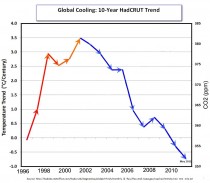
Figure 6. The trend of global temperature since 2001 has been cooling at a rate of -4.0C (-7F) per century. Computer models had predicted a 1F rise in temperature during this same period- that did not happen, showing that the computer models are invalid.
Summary
1. Rather than glacial retreat since 1904 due to gradual warming, glaciers have advanced and retreated four times in the past century.
2. Glacier termini advanced from 1945 to 1977 during the time of most sharply rising atmospheric CO2,. showing that rising CO2 does not cause climatic warming.
3. Glacier recession on Mt. Adams does not prove a gradually warming temperature.
4. No climatic warming has occurred during the past decade. Instead a cooling trend of -7 F per century has occurred.
5. Cooling during the past decade is not consistent with a claim of 50% reduction of Cascade snowpack caused by climatic warming.
6. The 1904 position of glacier termini resulted from strong cooling from 1880 to 1915. Comparing the position of recent minimal glacier termini following 20 years of warming from 1978 to 1998 with 1904 maximum glacier termini gives an exaggerated view of glacier recession.
7. Because glaciers on Mt. Rainier and Mt. Baker advanced and retreated four times in the past century, there is no basis for assuming that glaciers on Mt. Adams are retreating faster than those on nearby volcanoes.
References
Easterbrook, D.J., ed., 2011, Evidence-based climate science: Data opposing CO2 emissions as the primary source of global warming: Elsevier Inc., 416 p.
Easterbrook, D.J., 2011, Geologic evidence of recurring climate cycles and their implications for the cause of global climate changes: The Past is the Key to the Future: in Evidence-Based Climate Science, Elsevier Inc., p.3-51.
Easterbrook, D.J., 2010, A walk through geologic time from Mt. Baker to Bellingham Bay, WA: Chuckanut Editions, Bellingham, WA, 329 p.
PDF has enlarged images


